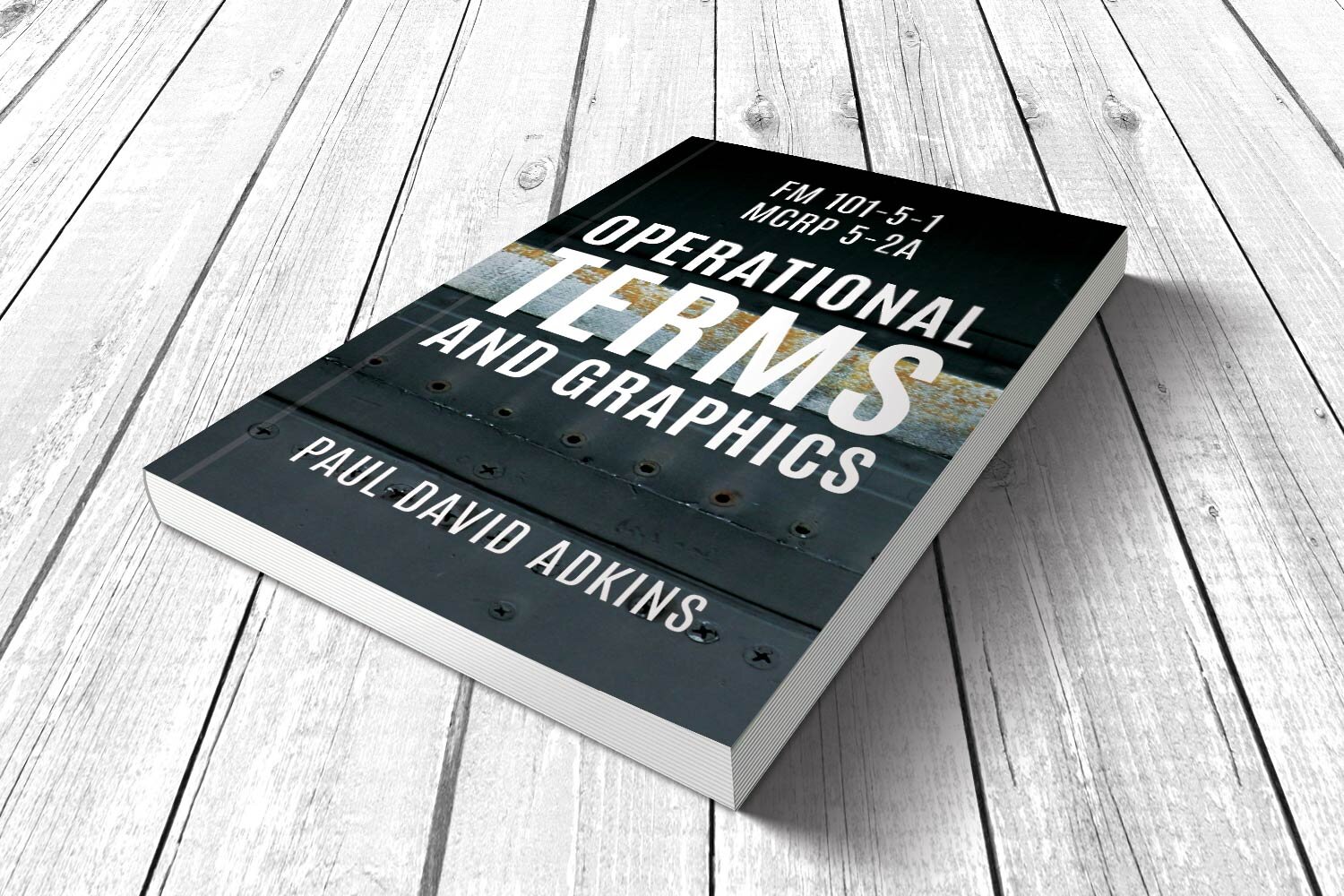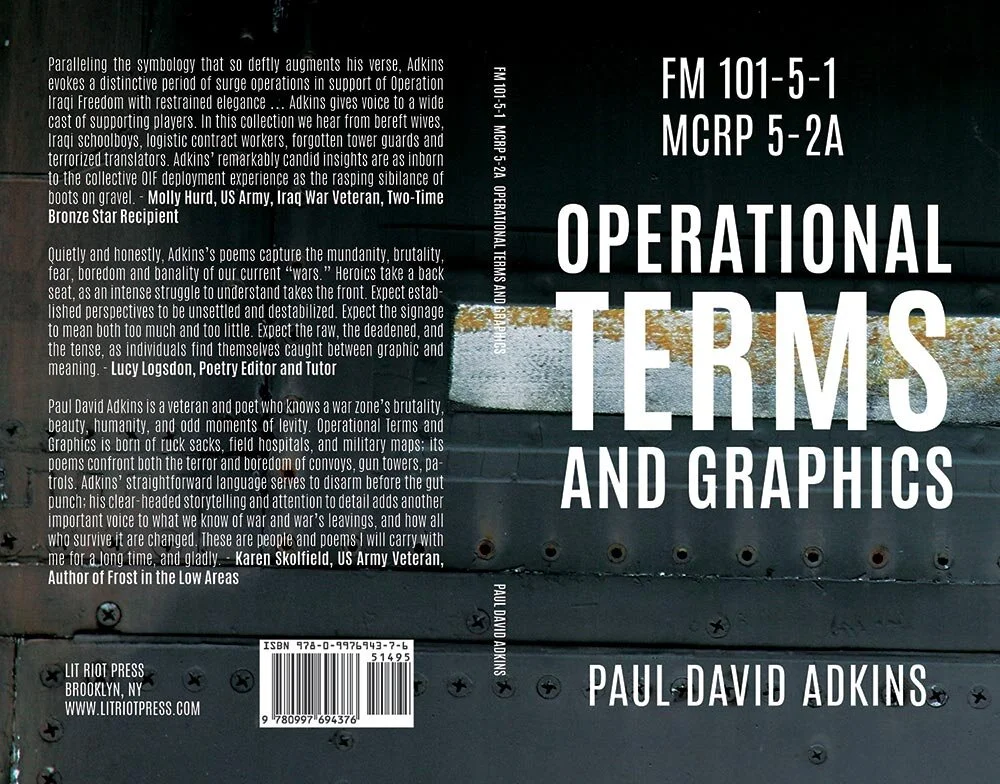FM 101-5-1 MCRP 5-2A: Operational Terms And Graphics
FM 101-5-1 MCRP 5-2A: Operational Terms And Graphics by Paul David Adkins
“Adkins’ straightforward language serves to disarm before the gut punch; his clear-headed storytelling and attention to detail adds another important voice to what we know of war and war’s leavings, and how all who survive it are changed. These are people and poems I will carry with me for a long time, and gladly.” – Karen Skolfield, US Army Veteran, Author of Frost in the Low Areas
About FM 101-5-1 MCRP 5-2A: Operational Terms And Graphics
To the enthusiast of military history, a good map tells everything: contour, overlook, reverse slope, avenue of approach, impassible obstacle. The unit symbols denote marches, routes, defenses, strongpoints. And yet, to the layman, the onlooker, the casual observer, they stand without value. They inherently cannot represent what is really happening on the battlefield to the single-most-important element: the combatant.
In Operational Terms and Graphics, I hope to divulge the human struggles beneath the symbols and designs: the struggles, the slaughter, the fear, the boredom, the hatred, and the torching that war lays upon the human spirit. Hence, I couple the maps and symbols with corresponding human experiences to counter the reporting of events so coldly depicted otherwise in news outlets, social media sites, memes, and sound bites. While I am not so naïve to think my poetry can singlehandedly stem the tide of professionally-crafted propaganda, bald-eagle posters, and war-glorifying movies, I am responsible, required, to add my voice to the debate, even a single dissenting text to oppose the hyper-patriotic, the ignorant, and the overwhelming proponency of war. Ice Cube famously claimed while a member of the band NWA, “Yo, Dre, I got something to say!” And so do I, as a soldier, a veteran, to my country and the world.
Many poets have employed their talents to warn us about this blood sport called war: Alan Seeger, Louis Simpson, Yusuf Komunyakaa, Karen Skolfield, and Harvey Shapiro, to name a few. And, accompanying the resonance of these masters, I ring the tiny chalice of my bell, to punctuate and highlight one soldier’s experiences during President Bush’s wars. I cannot speak for anyone else. But, “Insha’allah,” Arabic for “God willing,” I will speak clearly, concisely, precisely – a rifle shot, descending mortar round, incoming rocket – perfectly on point.
Buy $14.95
Poetry / Military Service / Iraq / Afghanistan
5 x 8 inches | 114 pages | Paperback | ISBN: 978-0-9976943-7-6 | $14.95 US
Buy: Amazon | Barnes & Noble | IndieBound | Waterstones
Reviews for FM 101-5-1 MCRP 5-2A: Operational Terms And Graphics
“Great read from a well-established author. Paul’s work is fantastic and should be read by anyone who has a veteran in their family.” – Amazon
“Paul David Adkins is a veteran and poet who knows a war zone’s brutality, beauty, humanity, and odd moments of levity. Operational Terms and Graphics is born of ruck sacks, field hospitals, and military maps; its poems confront both the terror and boredom of convoys, gun towers, patrols. Adkins’ straightforward language serves to disarm before the gut punch; his clear-headed storytelling and attention to detail adds another important voice to what we know of war and war’s leavings, and how all who survive it are changed. These are people and poems I will carry with me for a long time, and gladly.” – Karen Skolfield, US Army Veteran, Author of Frost in the Low Areas
“The poems in Paul David Adkins’ Operational Terms and Graphics are as tightly controlled and purposeful as the military formations that both physically and metaphorically overlay the collection. Paralleling the symbology that so deftly augments his verse, Adkins evokes a distinctive period of surge operations in support of Operation Iraqi Freedom with restrained elegance. Intuitively, Adkins counters the potential strangeness of military subject and terminology by exploring themes and scenes with which we are universally conversant. Regret, resignation, exhaustion, boredom, absurdity, rage, Adkins’ subjects shoulder wartime burdens with a vulnerability that is intensely human. Foregoing the bravado of traditional frontline narratives, Adkins gives voice to a wide cast of supporting players. In this collection we hear from bereft wives, Iraqi schoolboys, logistic contract workers, forgotten tower guards and terrorized translators. Adkins’ remarkably candid insights are as inborn to the collective OIF deployment experience as the rasping sibilance of boots on gravel.” – Molly Hurd, US Army, Iraq War Veteran, Two-Time Bronze Star Recipient
“The hybridity of Paul David Adkins’s new book, Operational Terms and Graphics, demands a reader sit up, pay attention. Military mapping and lexicon begin before the poems, thus pushing a reader to question structure, symbol, language and meaning’s locus almost immediately. Adkins takes a government codification system, one he was immersed in, and pairs that system’s signs with realistic, taut poems that humanize the symbols. Quietly and honestly, Adkins’s poems capture the mundanity, brutality, fear, boredom and banality of our current “wars.” Heroics take a back seat, as an intense struggle to understand takes the front. Expect established perspectives to be unsettled and destabilized. Expect the signage to mean both too much and too little. Expect the raw, the deadened, and the tense, as individuals find themselves caught between graphic and meaning. A key poem, “Hatred,” ends with these telling lines: Inside the truck, /the soldier’s rifle lay /smashed. / He thrust/ his one/ remaining/ middle/ finger/ up. Flipping the bird is no longer just flipping the bird. Symbols detach from their customary meanings, move to new destinations—some better, some worse, some hopelessly lost. This is what war does: destroys, alters, and, yes, creates, as Paul David Adkins so cleverly demonstrates in Operational Terms and Graphics.” – Lucy Logsdon, Poetry Editor and Tutor

